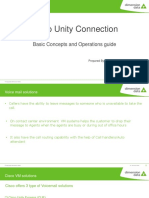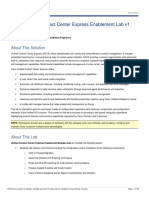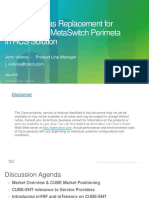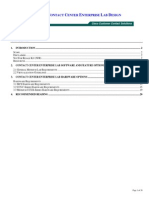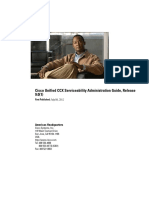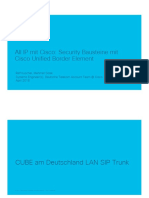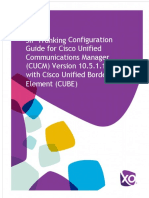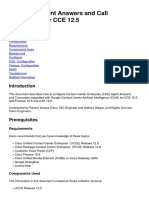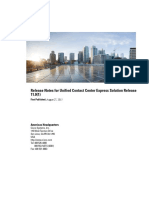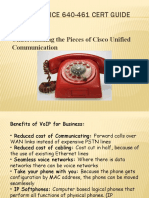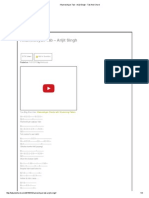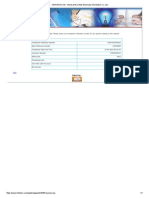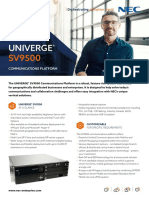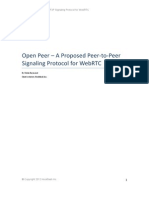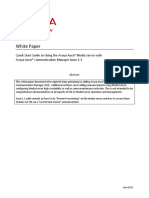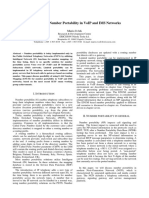Cisco Unity Connection
Rathish Kunath Technical Specialist
�What Is Cisco Unity Connection?
Telephony
(Cisco Unified CM, SIP, PIMG)
Exchange Server AXL/SOAP
Cisco Unified CM AXL/SOAP
Importing Users Set Forwarding Attributes
Appliance Platform
Cisco Unity Connection
MAPI
User GUI
User TUI or VUI Personal Routing
�Cisco Unity Connection: Messaging Solution
Easy-to-use voice mail, plus: Speech-activated dialing for corporate and personal contacts
Speech-enabled voice-mail browsing
Call transfer rulesby caller, time of day, calendar Integrated messaging for PC access Simple setup:
Complete install in less than an 2 hours, mostly unattended
Preinstalled on network appliance Standalone solution: No reliance on Microsoft Exchange or Active Directory No Microsoft Exchange experience required for voice-mail administration and maintenance
�Cisco Messaging Portfolio
Cisco Unity v7.x
Cisco Unity Connection 7.x per server
Cisco Unity 7.x per server Cisco Unity Connection 2.0 per server Cisco Unity Express 250 Users 3000 Users 7500 Users 10,000 Users
�Comparing Cisco Messaging Products
Cisco Unity: Unified messaging and intelligent voice mail for enterprise and midmarket customers with Exchange and Lotus Domino environments Cisco Unity Connection: Integrated messaging, speech recognition, and call routing rules in an easy-to-manage system for midmarket customers Cisco Unity Express: Cost-effective, integrated voice messaging and auto-attendant for small and medium branch office environments
Product Cisco Unity Express Cisco Unity Connection
Users Up to 250 Up to 10,000
Messaging Type Voice Mail Voice Mail Integrated Messaging Voice Mail Integrated Messaging Unified Messaging
Platform Router Based Server Based
Networking Yes Yes
Redundancy No Yes
Cisco Unity
7500 per server
Server Based
Yes
Yes
�Cisco 7800 Series MCS
Cisco Unity Connection is installed on the 7800 MCS server platforms
Note: Tower no longer shipped.
Minimum hardware requirements for Cisco Unity Connection 7.x: - 2-GHz Processor - 2 GB RAM - 72-GB Hard Disk (depending on clustering/features) For detailed model information check, Cisco.com
�Cisco 7800 Series MCS
Note: Tower no longer shipped.
7800 MCS server platforms (available from Cisco / HP=H / IBM=I): 7815(EOS)/7816 Series single processor/single power supply
* Platform Overlay 1 (previously shipped but supported)
7825-H4/I4 Series single processor/multiple power supplies
* Platform Overlay 1
7835-H2/I2 Series multiple processor/multiple power supplies
* Platform Overlay 2
7845-H2/I2 Series multiple processor/multiple power supplies
* Platform Overlay 3
7828-H3/I4 Series Co-resident Business Edition Pre-installed
�Platform Overlays for Linux
Description Platform Overlay Number 1 7825 Platform Overlay Number 2 7835 Platform Overlay Number 3 7845 Co-resident Configuration 7828
Platform Models Voice Mail Only
Total Ports (Voice + TTS + ASR)
Total number of ports (Active/Active node) Total Users with Mailbox Voice-Mail Users Cisco PCA Users Integrated Messaging (IMAP)
48
96 2000 1000 2000
96
192 4000 4000 4000
144
288 10,000 10,000 10,000
16
500 500 500
Total Ports (Voice + TTS + ASR)
Total number of ports (Active/Active node) Total Users with Mailbox Voice-Mail Users
24
48 1000 1000
48
96 3000 3000
72
144 7,500 7,500
16
500 500
Cisco PCA Users
Total Corporate Directory Users
1000
10,000
3000
10,000
7,500
10,000
500
1,000
�Cisco Unity Connection Telephony Integration
Cisco Unity Connection Telephony Integration
�Cisco Unity Connection Telephony Integration
Message Store
Cisco Unity Directory
Telephone System
(Cisco Unified CM, SIP, PIMG, TIMG)
Cisco Unity Connection
�Attributes of an Integration
Call forwarding to personal greeting Easy message access Message waiting indication
PBX or Cisco Unified Communications Manager
Call forward to personal greeting Easy message access
Message waiting indication
Cisco Unity Connection
�Cisco Unity Connection PIMG or TIMG Branch Consolidation
Cisco PIMG or TIMG Branch Office Support
Cisco PIMG Data Network
Cisco PIMG
Unlimited PBX locations Mixed PBX vendors
Multiple integration support:
SCCP, SIP, TDM
Cisco PIMG
�Cisco Unity Connection Telephony Integration
Supported Telephone Systems
Cisco CallManager 3.3(x) Cisco Unified Communications Manager 4.13, 5.x, 6.x, and 7.x Cisco CallManager Express 3.x Cisco CallManager Express 3.4 Cisco Unified Communications Manager Express 7.x Cisco SIP Proxy Server Avaya Definity G3 Avaya Definity ProLogix Avaya S8300/S8500/S8700 Nortel Meridian 1 QSIG phone system Siemens Hicom 300 Series E NEC NEAX 2400 ROLM 9751 More added regularly SCCP SCCP SCCP SCCP SCCP SIP PIMG PIMG PIMG PIMG IP using Cisco Unified CM PIMG PIMG PIMG
�Cisco Unity Connection Telephony Integration
Cisco Unity Connection Integration with Exchange
�Integration vs. Unified Messaging
Cisco Unity Connection supports Integrated Messaging:
Internet Message Access Protocol
Access to Voice Mails via an IMAP client - Unity Inbox - ViewMail for Outlook
Unity Connection
- Text to Speech (TTS)
Exchange / Domino
Cisco Unity supports Unified Messaging:
Voice Mails delivered to the users Inbox on Exchange/Domino
Access to Voice Mails via users Inbox
Unity Exchange / Domino
�Cisco Unity Connection Integration with Exchange
Cisco Unity Connection uses:
IMAP to access your e-mails and read them over the phone via TTS WebDAV to access your calendar for free or busy status and your personal contacts for name dialing
E-mail
Appointment Information MAPI
Client machine uses:
MAPI to get emails IMAP to listen to voice mails
My Personal Contacts
�Access to Voice Mail
Voice Mail access via phone (TUI) or voice (VUI) IMAP Client Access Cisco Unity Connection runs an IMAP service. Users configure IMAP access within their e-mail clients example: ViewMail for Outlook Unity Inbox Access through Personal Communication Assistant Licensed feature
�Standalone Deployment Model
Unity Connection Applications
IP WAN
Data Only
PSTN
�Standalone Deployment Model
New deployment variation for the single site deployment model: Cisco Unified Communications Manager Business Edition Cisco Unified Communications Manager and Cisco Unity Connection co-resident on a single server Single node appliance only no cluster Up to 500 mailboxes/575 IP phones
Use SRST for backup
Deploys as single site model
�Active/Active High Availability Deployment
New deployment model to support high availability and redundancy Maximum of two servers supported in a cluster pair One server is designated as a publisher The second server is designated as a subscriber or secondary server
Cisco Unity Connection Servers
Msgs
DIR
Msgs
DIR
Full Replication Two Unity Connection servers configured as a Cluster pair
�Digital Networking Deployment Model
Up to 5 Unity Connection servers and/or Cluster pairs can be networked together Supported over multiple geographic locations
Standalone UC
Active/Active Pair
Active/Active Pair
Standalone UC
Standalone UC
�Digital Networking Deployment Model
Cisco Unity Connection
Si
Digital Networking allows networking of up to five Unity Connection servers Digital Networking is NEW in Unity Connection 7.0 Uses SMTP for replication of messages between servers
WAN
Headquarters
Cisco Unity Connection
Digital Networking not supported with CUCM Business Edition Regional Office
�Voice Profile for Internet Mail (VPIM)
VPIM is an industry standard that allows different voice messaging systems to exchange voice and text messages over the Internet or any TCP/IP network Interoperability between disparate systems Support networking between different global directories supported in CUCM Business Edition VPIM is based on the SMTP and MIME protocols Support for up to 10 locations or systems Active/Active
Pair
VPIM
VPIM Standalone UC Running VPIM
Standalone UC Or Cisco Unity Express Standalone Unity Server
�Cisco Unity Connection Telephony Integration
Navigating Unity Connection Integration
�Logging into Cisco Unity Connection
The Username is defined during installation Can define additional usernames
The Password is defined during installation
Access to Cisco Unity Connection Administration by https://node-IP/cuadmin
Access to Cisco Unity Connection Serviceability by https://node-IP/cuservice
�Logging into Cisco Unity Connection
Access to Cisco Unified Serviceability https://node-IP/ccmservice
The Username is defined during installation The Password is defined during installation
Access to Disaster Recovery System https://node-IP/drf
�Logging into Cisco Unity Connection
Use the Administrator username and password (defined at the time of installation)
https://node-IP/cmplatform
Unity Connection uses Linux as the operating system no root access Use the OS Administration and CLI to access server configuration features
To access the command line interface use the Administrator username and password configured during installation Access to the CLI is through SSH only
�Cisco Unity Connection Telephony Integration
Cisco Unity Connection Administration
�Cisco Unity Connection Administration
Once logged in, use the Navigation menu to move to: Cisco Unity Connection Administration Cisco Unified Serviceability Cisco Unified OS Administration Cisco Unity Connection Serviceability Disaster Recovery System Then click Go
Cisco Unity Connection provides the administrator with the necessary tools to configure:
Users Class of Service
Templates
Contacts Distribution Lists Call Handlers Telephony Integrations Audiotext Applications Features
�Cisco Unity Connection Administration
Select the option from the left navigation pane to display the applicable configuration options in the page body
Review port configuration for the current integration: Select Telephony Integration > Port
�Cisco Unity Connection Telephony Integration
Port Configuration for Telephony Integration
�Port Configuration for Telephony Integration
Cisco Unified Communications Manager integration consists of a defined port group that includes one of more ports
CUCMx
Port Group: CUCMx-1
Port 1: CUCMx-1-001 Port 2: CUCMx-1-002
Cisco Unified Communication Manager 7.0 Configure two separate port groups for each server when using Active/Active cluster pairs
Cisco Unity Connection 7.0
�Port Configuration for Telephony Integration
Select the Display Name to change/view the various port configuration options
Ports are configured as members of a port group for a single integration Ports are licensed features in Unity Connection
�Cisco Unity Connection Telephony Integration
General Configuration
�General Configuration
In Cisco Unity Connection Administration, select System Settings > General Configuration
Configure System Defaults that will be applied to server and templates
Click Save to save settings. Exiting the screen without saving changes discards all setting changes.
�Cisco Unity Connection Telephony Integration
How the System Handles Calls
�Cisco Unity Connection Incoming Call Flow
1 4 9 IMAP or Cisco PCA 6
PSTN 3 5 2 8 Telephone System
Cisco Unity Connection
6. Cisco Unity Connection takes the message 1. User calls in to the system via the gateway at 2. from the outside caller and stores it on its 2. Gateway forwards the call to the Cisco Unified server. Communications Manager (telephone system) at 3. 3. Cisco Unified CM locates the endpoint and extends 7. Cisco Unity Connection sends the code to turn 10 9 8 7 MWI lightansweredthe isto to forward CallManager 6 Message into code subscriberthe MWI light on 5 Unity sends stored in theturn phonetheon the MWIsends it MWI light 4 Call callsis thethe theto codes tomessage caller 3 on to 4 3 CallManagerthemessage endpoint and extendsat the phone 2 Gateway forwards systemfrom the outside store at lightthe to 1 Useristakescomes onand thereturned togateway the2call at 10 Unity on the phone. not sends call the turn calls and looks at where on CallManager locates on through the call to 4. 8. Cisco Unified CM sends the codes to turn on 4. Call is not answered and is returned to Cisco the MWI light at 9. Unified Communication Manager. 9. On the phone, the MWI light comes on. 5. Cisco Unified Communications Manager looks at where to forward the call and sends it to Cisco Unity Connection.
�How the System Handles Calls
Outside (undefined) Callers: With the auto-attendant feature, callers can:
Directly enter a users extension Press 0 to connect to an operator Use a directory handler to find a users extension Use one-key dialing options, if implemented on the system Users: Star (*) key goes to Sign In Conversation
With identified user (recognized by defined DN):
Begin user conversation (sign-on) Send user to Self-Enrollment conversation (first time users)
Star (*) key goes to the Opening Greeting
�How the System Handles Calls
Unity Connection uses Call Handlers to determine the call flow and the users experience A call handler is a discrete set of call-processing instructions All underlying objects are call handlers System behavior is dependent on who is calling: Outside caller (or undefined phone): uses standard opening greeting Users: begins user conversation Routing Rules determine the callers experience and call direction
�Default Call Handlers
System Call Handlers Opening Greeting Goodbye Operator Directory Handlers System Directory Handler (All Users) Interview Handlers No Interview Handlers created by default
�Describing Call Handlers
Call handlers perform the following tasks: Answer calls Take messages Provide menus of key press options Route calls to users Route calls to other call handlers Play audiotext (prerecorded information) Directory Handlers Prompt caller to enter name by keypad or voice Match input to a selection and direct caller Interview Handlers Ask pre-recorded questions Forward responses to one or more users
�Default Call Handler Flow
Undefined / External Caller Opening Greeting
Select 4 Directory
Select 0 Operator
Leave Message Goodbye
�Cisco Unity Connection Telephony Integration
Understanding Users
�Understanding Users
Types of Users:
Users With Voice Mailboxes Able to Send and Receive voice messages
Ability to use features (Call Transfer Rules, Unity Inbox or Administration, etc)
Configured with phone extension Counted as voice mail license user Users Without Voice Mailboxes No ability to Send and Receive voice messages Ability to use Administration Not Configured with phone extension Not Counted as voice mail license
�Cisco Unity Connection Telephony Integration
Preparing to Configure Users
�Preparing to Configure Users
Steps to Configuring Users in Cisco Unity Connection:
1. Configure Authentication Rules Determines number of failed logon attempts before an account is locked Determines lockout policy lockout duration or manually unlocked
The minimum length allowed for passwords, expiration and trivial passwords
Two Authentication Rules are defined by default (voice and web) Controls access to features, such as Text to Speech email or live reply Controls how users interact with Connection (maximum length of messages and greetings, whether users can choose to be listed in directory assistance, and whether users can send messages to a system distribution list). Specifies the restriction table used to control the phone numbers that users can use for message notification, call transfer, and other tasks Two Class of Services are defined by default (voice and system)
2. Define Class of Service
�Preparing to Configuring Users
Steps to Configuring Users in Cisco Unity Connection (contd):
3. Configure Holidays and Schedules Determines which transfer rule and greeting is played Holiday Schedules are included in the Schedule configuration.
When a Holiday setting is in effect, Holiday greeting is played (if enabled) and closed hours transfer rules are observed
Each user and admin account created is based on a template
4. Configure Templates
Used to apply specific configuration setting to account at creation
Includes the Class of Service and the Authentication Rules Changes to templates do not affect existing user accounts Partitions and Search Spaces Roles Mailbox Stores (when using multiple mailbox stores) Unity Messaging Database -1 = UnityMbxDb1 (default)
5. Other Settings
�Cisco Unity Connection Telephony Integration
Configuring Users
�Configuring Users Configuring Authentication Rules
Select System Settings > Authentication Rules
Select the Voice Mail Authentication Rule to edit configuration (next slide)
�Configuring Users Configuring Authentication Rules
Authentication Rules apply to user account Password settings of the template/user account
Click Save
Select Authentication Rules: Failed Logon Attempts Lockout Duration Credential Length Trivial Passwords
�Configuring Users Class of Service
Authentication Rules apply to all members
Select the Voice Mail Authentication Rule to edit configuration (next slide)
�Configuring Users Class of Service
Class of Service controls which features and options are available to the user
Class of Service allows access to: Directory Listing Licensed Features Alternate Extensions Message Options Private Lists Call Transfer
�Configuring Users Schedule and Holidays
Holiday Schedules are applied to Schedules: Play holiday greeting (if enabled) Observes closed transfer rules A Schedule includes one of more holidays
Select the Schedule to edit the configuration (next slide)
Create a new Holiday Schedule by selecting Add New
�Configuring Users Schedule and Holidays
�Configuring Users Schedule and Holidays
�Configuring Users Configuring User Templates
Note: Changing a User Template does not affect existing user accounts
User Templates apply: Authentication Rules Class of Service Schedule / Time Zone Configuration settings
�Configuring Users
After creation, all options that apply to a user can be changed through the User Basics and Edit dropdown
�Cisco Unity Connection Telephony Integration
Understanding Contacts
�Understanding Contacts
Contacts:
Users without Voice Mailboxes or mailbox located on another system No access to features and voice messaging
Contact Capabilities
VPIM Messaging Mailbox exist on another system Directory Access Allows contacts to be access by the directory Name Dialing Access users can place phone calls to contacts using speech recognition Personal Call Transfer Rules contacts available to personal call transfer rules How System Contacts Are Used: Internal user that has a voicemail account on another system Staff, vendors or partners that need to communicate with users but do not need a voice mailbox
�Rathish Kunath Technical Specialist Rathish.Kunath@wipro.com

